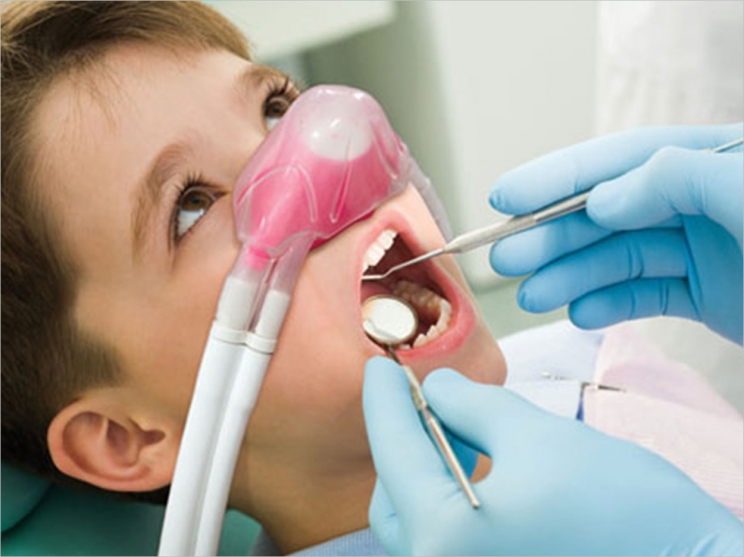Nitrous Oxide helps kids be comfortable during dental appointments.
For some children, dental appointments can be intimidating, especially if the child is anxious. At Pebble, it is our goal is to provide pediatric dental patients with a positive experience in a safe, stress-free environment. One way we are able to achieve that is through the use of nitrous oxide, often referred to as “laughing gas.” This mild form of sedation is commonly used to relieve anxiety and discomfort during dental procedures.
What is nitrous oxide? When is its use appropriate for children?
Nitrous oxide is a colorless, odorless gas that has been deemed safe for use in children by the American Academy of Pediatric Dentistry. For children who
- experience fear and anxiety about dentist visits and procedures
- have a short attention span or difficulty following instructions and sitting still
- have a strong gag reflex that could interfere with the dentist’s ability to perform routine procedures
- have special health care needs
- are resistant to local anesthesia due to fear
- will be undergoing a prolonged dental procedure
Nitrous oxide can help to relax and soothe them, allowing them to remain calm during routine cleanings, fillings, or other procedures. Being relaxed during dental procedures not only ensures their physical safety, but encourages a positive dental experience and better overall dental care.
Small doses of nitrous oxide are completely harmless and have been used safely in pediatric dentistry for many years.
What is the purpose of nitrous oxide? What are the benefits?
Nitrous oxide can be used for a wide range of dental procedures, from cleaning teeth to filling cavities. Certain procedures may also require local anesthesia. Qualified board certified pediatric dentists like Dr. Post will be able to manage any discomfort and anxiety together to help young patients maintain good oral health.
There are numerous benefits to using nitrous oxide:
Quick to relax.
Unlike other types of sedation dentistry, nitrous oxide relaxes a child without putting them to sleep, leaving the patient awake and responsive during the procedure. Nitrous oxide helps children relax while sitting in the dentist’s chair so they can get the care they need to maintain a healthy smile without fear, anxiety, or upset. It is referred to as “laughing gas” because one of the side effects associated with it is a feeling of well-being or euphoria. As a result, a child may giggle or laugh a little during treatment, but they will still be able to fully cooperate with the dentist.
Quick to wear off.
One of the wonderful attributes of nitrous oxide is that it takes effect quickly and is reversed quickly. Nitrous oxide wears off as soon as the breathing mask is changed to release only 100% oxygen at the end of the dental procedure. A common misconception is a comparison to oral sedation which can result in lingering grogginess or sleepiness, and requires careful monitoring for the first several hours. The effects of nitrous oxide however dissipate immediately and recovery time is complete before the patient leaves our office. School-aged children are often able to return to the classroom after their appointment is over!
No lingering side effects.
Because there are no lingering side effects from nitrous oxide, it is safe for patients of all ages, including young children. As it is being administered, a child may feel slightly light-headed or that their limbs are heavy. This is a normal reaction, and as mentioned above, will disappear as soon as the patient receives pure oxygen at the end of treatment. The overall feeling while being sedated with nitrous oxide is one of safety and relaxation, allowing the dentists to complete the procedure successfully without any anxiety for the patient.
How is nitrous oxide administered to my child?
Pediatric nitrous oxide is delivered through a small fitted mask that covers the child’s nose. The mask carries oxygen mixed with nitrous, and as the patient breathes in normally through their nose, uptake occurs in the lungs. The sedation takes effect in about five minutes, though the mask will remain in place throughout the procedure. Once treatment is complete, the nitrous will be turned off, and the child will breathe in pure oxygen for a few minutes in order to clear out any remaining gas. Occasionally, nitrous oxide may cause mild nausea. For this reason, we suggest only a light meal for a patient prior to their dental appointment.
What can I expect before, during, and after nitrous oxide use?
With the right preparation beforehand, and proper care afterwards, dental sedation with nitrous oxide is a safe and simple process. Each experienced member of Pebble communicates clearly with each patient and parent in order to provide the best possible experience for the child.
Before nitrous oxide sedation:
While it is not necessary to restrict food and drink after midnight before an appointment where nitrous oxide will be used, children should only be given light food. We encourage parents to dress children comfortable clothing, as this will improve their overall experience. A full medical history will be required, including any current prescriptions, over the counter medications, vitamins, or supplements. One of the most important things we ask is if our patients have any respiratory infection, ear infection, cough, or cold to let us know before the appointment. If our patient is not able to adequately breathe in the nitrous oxide gas then it will not be effective for their appointment. If you have any specific questions please just ask us.
During nitrous oxide sedation:
We have found that our young patients have a much easier time relaxing if parents remain calm and encouraging. For children who have them, comfort items like a favorite toy or lovey can help bring a sense of familiarity to the procedure, but holding the child’s hand and speaking to them in a gentle tone has a similar effect. We encourage parents to leave other children at home or in the waiting area if at all possible in order to focus their full attention on the child receiving sedation. In fact, most of our parents are comfortable staying in the reception area while the procedure is being performed. This allows the patient to focus on the instructions given by the dentist treating them.
After sedation:
As mentioned above, there are no lasting effects when nitrous oxide is used. Children may return to school or daycare after their appointment. Depending on the procedure, the patient may be limited to soft food for a few hours, and parents or caregivers should contact the dentist immediately if there is any vomiting, severe pain, severe bleeding, or fever. Once the child’s mouth has healed, the normal dental hygiene routine may resume.



















